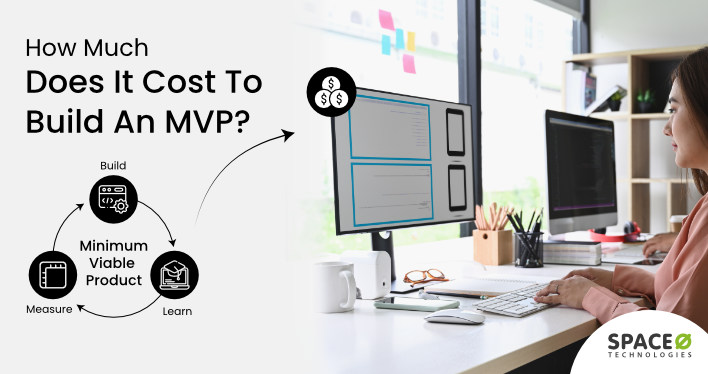A simple web search of “How much does it cost to build an MVP” on Google generates several results. These results add more confusion rather than providing clarity on the MVP cost.
An MVP is a basic version of your product that only includes the functionality required to collect feedback from early users. From idea to launch, every stage of MVP development comes with its own set of expenses.
Space-O Technologies has over 13 years of expertise offering MVP development services. We understand the complexity of creating MVPs and the value of cost transparency. Thus, we have provided you with a detailed cost structure of MVP.
Let’s first discuss the reasons why planning your MVP budget is important.
Contents
- Why Is It Important To Budget Your MVP Development?
- How Much Does It Cost To Build An MVP
- Factors Influencing the MVP Development Cost
- 5 Tips for Reducing MVP Development Costs
- Hidden Cost Involved in MVP Development
- Real-world Examples of Minimum Viable Product
- Frequently Asked Questions
- Develop Your MVP With Space-O Technologies
Why Is It Important To Budget Your MVP Development?
Here are the reasons why is it important to budget your MVP development for startups.
- Resource Allocation: Planning allows you to distribute time, money, and people where they are most needed, ensuring that critical activities are prioritized.
- Clear Expectations: Cost estimation for minimum viable product enables investors, team members, and clients to set realistic expectations, building trust as well as transparency.
- Risk Mitigation: Anticipating financial concerns allows you to solve issues ahead of time, decreasing project delays and failures.
- Scalability: A precise budget for MVP sets the framework for future development by directing scaling and expansion decisions.
After discussing the reasons why planning the cost of MVP for software development is important, Let’s check out the cost associated with MVP development.
How Much Does It Cost To Build An MVP (Minimum Viable Product)
The average cost of developing a minimum viable product (MVP) ranges from $10,000 to $50,000, with a small team of 2-5 members including a designer, a developer, and a project manager. The precise cost depends on the features to include, the technology stack used, and the level of customization.
Let’s help you understand the cost breakdown of MVP development in detail.
Pre-development Cost of MVP
Here is the cost breakdown of the pre-development cost.
Market Research and Validation
Cost Range: $1,000 – $10,000
Timeline: Varies
The cost range varies based on the level of research you carry out like conducting surveys, interviews, and analyzing competitor strategies. The timeline for research is not fixed. This phase requires several weeks to gather and analyze relevant data to ensure the MVP aligns with market demands and exceeds user expectations.
Prototyping and Wireframing
Cost Range: $500 – $5,000
Timeline: 1-2 weeks
Prototyping and wireframing allow you to examine your MVP’s user experience and functionality before it is developed. This cost includes the making of initial plans, wireframes, and interactive prototypes. The timing varies depending on the complexity of the MVP and the number of iterations required to finish the design.
Product Design
Cost Range: $1,000 – $15,000
Timeline: 2-4 weeks
Investing in product design ensures that your MVP is both visually appealing and easy to use. Product design costs include UI/UX design, visual resource creation, and iterative design adjustments based on feedback. And, the timeline depends on the scope of design requirements and several design iterations.
Development Cost of MVP
Here is the table containing the cost breakdown and timeline of the development phase of an MVP.
Cost Category Cost Range Timeline Front-end Development $5,000 – $30,000 4-8 weeks Backend Development $5,000 – $40,000 4-8 weeks Database Setup $1,000 – $10,000 1-2 weeks Third-party Integrations $1,000 – $20,000 2-4 weeks Testing and Quality Assurance $2,000 – $15,000 2-4 weeks Note: The above-mentioned cost and timeframe are estimates and fluctuate based on the project’s complexity, unique needs, and development partner.
Front-end Development
Front-end development emphasizes user interfaces and interactions with your MVP. Front-end expenditures include HTML/CSS code, JavaScript functionality, and responsive design for mobile, tablet, and desktop computers. The variety of UI elements and engaging features define the timeline of the front-end development.
Backend Development
Backend development includes creating server-side logic and databases for data processing, user authentication, and system scaling. Backend cost covers programming, database integration, and API development. The timeline also varies based on business logic and data handling requirements.
Database Setup
Database setup ensures to store and manage your MVP’s data. The cost associated with a database includes database design, setup, and optimization for performance and scalability. The complexity of data storage and retrieval needs determines the timeline.
Third-party Integrations
Integrating third-party services improves your MCP’s functionality and expands capabilities. The cost of integration is based on APIs, payment gateways, and other external services to enrich the user experience.
Testing and Quality Assurance
Quality assurance and testing are necessary to make sure your MVP satisfies requirements and provides users with an effortless experience. This cost is based on test planning, execution, bug fixing, and ensuring compatibility across platforms. These platforms include web browsers, mobile devices such as iOS and Android, as well as operating systems such as Windows, macOS, and Linux.
Get Tailored Quotes for Your MVP Project
Planning to build an MVP web, mobile app, or software product? Get a free, no-obligation cost estimate from our experts.

Post-development Cost of MVP
Here is the cost breakdown of the post-development cost.
Launch and Deployment
Cost Range: $1,000 – $5,000
Timeline: 1-2 weeks
Launching and deploying your MVP to production servers or app stores requires careful planning and execution. The cost associated with this phase is based on hosting setup, domain registration, and submission to app marketplaces. And, the timeline varies depending on the selected platform like AWS & Azure and the deployment process selected like (CI/CD) pipelines or manual deployment procedures.
Initial Marketing and User Acquisition
Cost Range: $2,000 – $20,000
Initial marketing consists of attracting the first adopters and increasing user involvement. Digital marketing campaigns, content production, and user acquisition tactics specific to your target demographic determine the cost.
Maintenance and Support
Cost Range: $500 – $5,000
To keep your MVP effective, secure, and current, regular maintenance and support are required. During this phase, the cost is determined by monitoring, problem patches, and customer assistance to handle user input and maintain an ideal user experience.
After discussing each cost of MVP development, let’s help you cover all the factors influencing the MVP development price.
Factors Influencing the MVP Development Cost
Check out the factors that influence the MVP development cost.
Complexity of the MVP Development Project
Here is the table showcasing the minimum viable product cost based on the complexity of the project.
MVP Complexity Features Cost Range Simple - Basic Landing Page
- Subscription Functionality
$5,000 – $10,000 Medium - User Registration
- Basic Profile Management
- Payment Integration
$10,000 – $30,000 High - Social Media Integration
- Real-time Chat Support
- Customizable User Dashboards
- Multi-language Support
$30,000 – $100,000 Note: The expenses shown above are estimates and vary based on the precise project requirements, customization demands, and any new features to be included.
Simple MVPs involve minimalistic features aimed at testing core concepts and validating market demand. For example, a basic landing page with subscription functionality allows users to sign up for updates or newsletters. The timeline to develop an MVP ranges from 2 to 4 months.
Medium complexity MVPs expand upon the basic functionalities of simple ones to provide a better user experience. The average timeline to develop this type of MVP ranges from 3 to 6 months.
High-complexity MVPs represent the most advanced stage of product development. This MVP integrates advanced features like AI-driven recommendations & predictive analytics to deliver personalized experiences and optimize user interactions. The timeline involved in developing such a complex MVP is 6 to 12 months.
Geographical Location
Considering cost based on locations helps make better decisions when selecting development teams and optimizing budget allocation for your projects.
Country Cost Range United States $50,000 – $200,000+ Canada $40,000 – $150,000 United Kingdom $45,000 – $180,000 Australia $50,000 – $200,000 India $10,000 – $50,000 Ukraine $15,000 – $70,000 Poland $20,000 – $80,000 Brazil $20,000 – $90,000 Note: The charges in the table are approximate and vary based on the project complexity, specific requirements, and development team expertise.
Analysing MVP development costs in different countries helps you allocate and plan resources. These costs vary based on labor expenses, skill level and economic conditions in each region.
Type of Development Platform
Selecting the right development platform defines the accessibility, performance, and user experience of your MVP. The development cost depends on the following types of platforms.
Web Applications
Cost Range: $10,000 to $50,000
Timeline: 2 to 4 months
Creating web applications involves leveraging web technologies such as HTML, CSS, and JavaScript to create platforms that are accessible through web browsers. Web-based MVPs rapid iteration and feedback gathering with shorter development costs and lower costs compared to mobile and desktop applications.
Mobile Applications (iOS, Android, or Cross-platform)
Cost Range: $20,000 to $100,000 or more.
Timeline for Native Application: 3 to 6 months
Timeline for Cross-platform Solution: 2 to 4 months
Developing an MVP as a mobile application provides an opportunity to engage with a wide range of audiences including iOS and Android users. Cross-platform development offers cost savings but extends the timeline to ensure platform compatibility and optimization.
Desktop Applications
Cost Range: $20,000 to $150,000
Timeline: 3 to 6 months
Desktop applications require more thorough testing to guarantee compatibility with various operating systems such as Windows, macOS, and Linux. However, these applications have shorter development cycles and lower costs compared to mobile apps.
Choice of Technology Stack
Considerations like scalability, flexibility, and simplicity of maintenance are important when choosing programming languages, frameworks, and tools. The technology you choose should be in line with your project needs, team competence, and long-term objectives.
Tip
The MEAN stack including MongoDB, Express, Angular, and Node is a versatile and real-time data handling framework that should be considered while designing and developing MVP web platform. Also, if you value performance and scalability, a microservices design based on technologies such as Docker and Kubernetes is more suited.
UI/UX Requirements
A well-designed user interface or user experience influences user engagement, adoption, and retention rates. Here’s an overview of the factors that determine the cost of UI/UX development.
- Visual design and branding elements (logo, color schemes, typography, etc.)
- Wireframing and prototyping
- Responsive design for various devices and screen sizes
- Accessibility and compliance with industry standards
- User research and persona development
- Information architecture and navigation structure
- Usability testing and iterative design
- Interaction design and animation
UI Design
UX Design
As the complexity and functionality of your UI/UX needs rise, so do the development costs. If you engage expert UI/UX designers or companies, expect to pay a premium.
Development Team Structure
Here is the table containing the cost and timeline of MVP app development based on the MVP development team structure.
Team Structure Cost Range Timeline In-house Team $50,000 – $200,000+ 3-6 months Outsourcing to a Development Agency $20,000 – $100,000 2-5 months Hiring Freelancers $10,000 – $50,000 2-4 months Note: The charges indicated in the table are approximate and vary based on the project complexity, team skill, and geographical location.
Let’s discuss each development structure in detail.
In-house MVP Team
For startups and small organizations, developing an MVP with in-house resources is the costliest alternative. The cost is associated with hiring full-time developers, designers and project managers. However, having an in-house development team provides better control over the entire development process, easier communication, and the ability to adapt to changes quickly.
The costs include salaries, benefits, office space, equipment used, and overhead expenses for the in-house development team. Furthermore, the time needed to hire and integrate new team members also expands the time required for development.
Outsourcing to a Development Agency
Outsourcing MVP development to a reliable development agency is way more cost-effective than hiring in-house experts or freelancers. Agencies offer experienced and talented developers, designers, and project managers.
The outsourcing price depends on the agency’s expertise, location, and aspects of a project which are complex and overhead costs. In the USA or Western Europe, the agencies have higher overheads than the others, but they have an in-depth understanding of the local market dynamics, cultural contexts and regulatory requirements.
Before you choose to outsource MVP development, consider such factors as the agency’s success in developing individual MVPs, the communication channels used, and time zone compatibilities. However, finding a reliable MVP app development company is difficult and time-consuming. Check out our curated list of top MVP development companies.
At Space-O Technologies, our skilled developers have a track record of creating MVPs for a variety of industries. We prioritize open and transparent communication to keep you updated throughout the entire development process of developing an MVP app.
We recently developed minimum viable products, including an online learning platform and an on-demand food delivery app. These MVPs were developed, launched, and achieved significant success. The online learning platform secured $1.4 million in funding, while the delivery app was selected by Apple for its “Best of 2016” award and accumulated 50 million downloads.
Our project management methodology, along with Agile and Scrum methods, guarantees that your MVP project is completed promptly. We also employ collaborative tools such as Jira, Trello, and Slack to communicate clearly between geographically separated teams. Contact us to discuss your MVP requirements.
Hiring MVP Freelancers
Hiring freelancers turns out to be one of the best options among many to develop MVPs for businesses with a small budget. These experts are hired based on an hourly basis or project-wise rates, which, in turn, are lower than agencies and in-house teams.
However, leading a team of freelancers is difficult. This necessitates combining freelancer efforts, setting up regular communication, and keeping quality control. Also, hiring motivated and qualified freelancers takes time with the risk of turnover or availability issues.
Here is the cost breakdown of the cost associated with hiring freelancers for your MVP development.
Freelancer Type Hourly Rate (USD) Junior Developer $20 – $40 Senior Developer $50 – $100 UI/UX Designer $30 – $60 Project Manager $40 – $80 Note: The charges in the table are approximate and vary based on the freelancer’s experience, expertise, and project complexity.
Screening and interviewing are necessary steps to identify a freelancer who has the relevant skills, experience, and work ethic for your MVP project. Explore platforms such as Upwork, Freelancer, and Toptal to source and employ talented freelancers. You must define clear expectations and give consistent feedback to ensure to overcome the challenge of managing a freelance team.
Further, let’s learn the tips that help you reduce your MVP app development cost.
5 Tips for Reducing MVP Development Costs
Here are the tips for reducing the MVP app development costs.
Prioritize Minimum Viable Features
What you need to do: Work closely with your development team to identify and prioritize essential features required to test your core product.
Result: Reduced scope leads to fewer development hours and lower costs.
Opt for a Lean Design Approach
What you need to do: Provide design standards that prioritize clear and practical UI/UX above unnecessary visual graphics and animations.
Result: A streamlined design process with less front-end coding reduces design and front-end costs.
Leverage Open-source Tools
What you need to do: Evaluate high-quality open-source alternatives for components like UI libraries, databases, and testing frameworks before building custom solutions.
Result: Substantial savings by using free and well-tested open-source tools versus proprietary paid solutions.
Opt for Offshore Development
What you need to do: Partner with a reputable offshore development vendor in a cost-competitive region like North America, Eastern Europe, or Southeast Asia.
Result: Access to skilled developers at significantly lower hourly rates compared to in-house or domestic outsourcing.
Consider a Fixed-price Model
What you need to do: Once the scope of your project is finalized, negotiate a detailed fixed-bid contract that covers the entire MVP development lifecycle.
Result: Predictable costs with no risk of chargeable hour overruns, resulting in more effective financial planning.
Need Help With MVP Development?
At Space-O Technologies, we have a team of 140+ developers to help you build budget-friendly MVPs that help test ideas effectively.
Now, check out the hidden cost of MVP development that impacts your initial MVP development budget and timeline.
Hidden Cost Involved in MVP Development
Here are the hidden costs involved with MVP development.
Expansion of Project Requirements
Requesting additional features or changes during development leads to increased development time and resources. This affects the MVP project’s entire budget.
Development Shortcuts Consequences
Quick fixes or shortcuts to meet deadlines result in addressing technical debt later on. This requires additional time and resources which impacts the project’s overall progress.
Challenges in Third-party Integration
Challenges in integrating third-party services or APIs lead to increased project expenses. These expenses arise from licensing fees, customization requirements, and unexpected integration challenges.
Legal and Industry Standards Adherence
Ensuring compliance with industry regulations or data protection laws requires additional legal and consulting fees. These fees directly impact the project’s budget and require careful consideration during planning.
Testing Efficiency and Bug Detection
Detailed testing on multiple devices and platforms increases testing costs and project delays. These delays occur due to unforeseen issues that are not covered during the testing phase.
User Feedback Iterations
Implementing user feedback requires additional development cycles and resources. These extend the project’s timeline and budget to integrate user suggestions.
Let’s discuss a few of the top examples of minimum viable products.
Real-world Examples of Minimum Viable Product
Here is a table showcasing popular examples of solutions that originated as Minimum Viable Products (MVPs).
| Examples | Product | Minimum Viable Features | Result |
|---|---|---|---|
| Dropbox | Cloud-based file storage and synchronization service |
| Dropbox initially launched with these core features to enable cross-device file storage and access. This minimalistic approach validated market demand and facilitated iterative development based on user feedback which helped evolve as a cloud storage platform. |
| Social media platform for photo sharing |
| Instagram began as a photo-sharing app, prioritizing simplicity and visual storytelling, which quickly garnered a vast user base. It was acquired by Facebook and evolved into a multifaceted platform for sharing photos, videos, and stories. | |
| Social media platform for microblogging |
| Twitter initially offered concise updates and messages, resonating with users due to its simplicity and real-time communication. Over time, it evolved into a widely-used social media platform by incorporating user feedback to add new features and functionalities. |
After discussing each aspect of MVP development from cost breakdown to the popular examples of minimum viable products, let’s check out the FAQ section.
Frequently Asked Questions
What are the benefits of successful MVP app development?
Here are the benefits of a successful MVP app development.
- Accelerate your product launch and start gathering feedback from users sooner.
- Minimize development costs by focusing on essential MVP features required for validation.
- Gather valuable insights from the target audience to iteratively improve your product.
- Validate your product concept in the real market to ensure demand and relevance.
- Continuously enhance your product based on real-world usage data and user feedback.
- Mitigate market risk by assessing viability with minimal investment and the flexibility to pivot if necessary.
What are the common mistakes to avoid when building an MVP?
Here are the common mistakes to avoid when developing an MVP.
- Overcomplicating the MVP by including too many features beyond the core value proposition.
- Neglecting to actively gather and incorporate user feedback throughout the development process.
- Sacrificing quality standards in terms of design, functionality, or user experience.
- Underestimating the time and resources required for MVP development, leading to delays and budget overruns.
- Failing to consider future growth and scalability from the outset, resulted in technical debt and architectural limitations.
What is the difference between an MVP and a prototype?
An MVP is a minimum yet functional version of a product that includes only the must-have features necessary to solve a core problem for early adopters. This allows for real user feedback and potential revenue generation. In contrast, a prototype is a preliminary model or sample with limited functionality. This is primarily used for testing and evaluation purposes during the product development phase before a fully-fledged product is built.
Develop Your MVP With Space-O Technologies
Getting the precision minimum viable product cost is challenging since multiple factors like project complexity, development team expertise and technical requirements affect the MVP cost. This guide has helped you provide a complete cost breakdown along with the hidden costs and tips to reduce expenses.
If you want to develop MVP, partner with Space-O Technologies. With 14+ years of experience and a pool of experienced developers, we help you through each step of the MVP development process. Get our MVP development team to develop your custom minimum viable product. Schedule a meeting with us.




